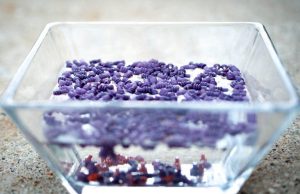The density, or its reciprocal, the specific volume, is a commonly used property for polymeric materials. Density is primarily used as a material control tool, as well as to compare the buoyancy of different materials, but it can also be used to calculate the mass of rubber required to produce a given volume of material. The density of compounds with fillers or different materials can be computed at any temperature using the rule of mixture. Density measurements are performed following the standard tests ISO 1183 and ASTM D792. The density of Liquid Silicone Rubber (LSR) is typically in the range of 1.10 – 1.50 g/cm3 (density of natural rubber: 0.92, EPDM: 0.86 g/cm3), so it will sink in water (density of water: 1 g/cm3).
As with other properties, the specific volume is greatly affected by the temperature and pressure. Temperature and pressure are both important for processing and is described in the post “Expansion or Shrinkage.”

[1] ASTM D 792: Density and Specific Gravity (Relative Density) of Plastics by Displacement; ASTM International, 2008
[2] ISO 1183-1: Plastics – Methods for determining the density of non-cellular plastics – Part 1: Immersion method, liquid pyknometer method and titration method; International Organization for Standards, 2004
[3] Osswald, T. A.; Baur, E.; Brinkmann, S.; Oberbach, K.; Schmachtenberg, E.: International Plastics Handbook; 4th edition, Hanser Gardner Publications, Cincinnati, 2006
[4] Campo, E. A.: Industrial Polymers
The information provided herein is to the best of our knowledge and it is believed accurate and reliable as of the date compiled. No representation, warranty or guarantee expressed or implied, is made as to the accuracy, reliability or completeness of the information provided herein. It is the user’s responsibility to determine the suitability and completeness of such information for the intended use. We do not accept liability for any loss or damage that may occur from the use of this information. Nothing herein shall be construed as a recommendation for uses which infringe valid patents or as extending a license under valid patents.